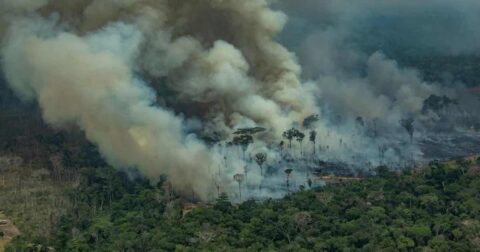Feature
The Meat Industry’s Hidden Link to Wildfires
Climate•6 min read
Explainer
The fires in Brazil are part of a global problem, one which highlights the direct link between deforestation and loss of ecosystems with dietary choices made thousands of miles away.


Words by Devatha P. Nair
Chances are that the fires burning in the Amazon did not cross our minds as we sat down to a breakfast of scrambled eggs on a Sunday morning. Nor did we think of the jaguar with her blackened paws lying helplessly asphyxiated in the Pantanal wetlands as she tried to outrun multiple fires, amidst the 700,000 hectares ablaze, or the plight of the burnt caiman, found with his mouth agape in a last desperate scream as the flames engulfed him.
The fact remains: The fires burning in Brazil’s Amazon, Pantanal, and Cerrado biomes are done so on purpose by livestock farmers to turn dense forest into pasture and soybean crops. These fires put millions of wild animals in harm’s way, and they are directly connected to the growing demand for meat and dairy products. The fires in Brazil are part of a global problem, one which highlights the direct link between deforestation and loss of ecosystems with dietary choices made thousands of miles away. Above all, the blazes reiterate the sheer unsustainability of animal agriculture and tragedy within our current food systems.
“Seeing the impact of these fires on the environment and wildlife is devastating,” says Joao Almeida, Executive Director of World Animal Protection (WAP), Brazil. “We have seen baby deer with their legs burned, animals such as monkeys and jaguars completely carbonized, and others with their paws burnt, completely dehydrated or starving.”
According to Brazil’s National Institute for Space Research (INPE), the fires have already destroyed homes and farms and sent humans to the hospital for respiratory problems. And while the fires leave behind the charred remains of vertebrate and invertebrate animals, they may have irrevocably destroyed the habitat for millions of other animals.
“What we are seeing is that just with the fires of the past two years, endemic species are disappearing from the areas they used to inhabit in all three biomes,” said Dr. Luisa Diele-Viegas, an ecophysiologist with the Institute of Biological and Health Science at the Federal University of Alagoas in Brazil. “While assessing the impact of climate change on these species for the next 10, 30, or 50 years, we don’t know if they will even be around that long for us to worry about how they will adapt to the new environment. They are all just gone.”
The majority of Brazil’s fires are human-made fires used to clear large areas of forest and make way for pastureland and soybean crops. They are responsible for the death and suffering of millions of wild animals every year. While global leaders, corporations, and shareholders are committed to minimizing the impacts of climate change acknowledge that we are currently not on track to meet the goals set out by 2030, they stop shy of listing global meat consumption and factory farms as the major contributors to the current crisis and detail no plans in place to educate the public on how consumers have contributed to the current state of affairs.
Even global events such as COP26—that list “curtail deforestation” and “protect and restore ecosystems” among their primary goals—hesitate to acknowledge global meat consumption as the primary driver of deforestation and ecosystem destruction in the first place.
Not coincidently, the active fire seasons of each of the last three years in the biomes of Brazil also coincide with a massive relaxation in regulations, fines, warnings, and a decline in the seizure of illegal equipment in protected areas. Deforestation is at an 11-year high as of last year while the number of fines imposed for illegal deforestation and environmental offenses has fallen sharply. Also not coincidently, Brazil’s 2021-2022 soybean crop is projected to be its largest to date, at nearly 5.2 billion bushels, representing an increase of 3.9 percent over the previous harvest.
Brazil remains the largest exporter of soybeans, beef, and chicken in the world, and so farmers and ranchers are motivated to acquire more acreage towards soybean crop plantations. While soybean acreage in Brazil is expected to reach a record-breaking 99 million acres, the demand for land has unleashed a cascade of detrimental events in the tropical forests and grasslands that are deforested. The converted soybean plantations displace cattle ranchers, who in turn, burn more forests to make room for pasturelands. This trend is unlikely to change. Driven by a strong U.S. dollar and the Chinese demand for soybean crops, the historically high profits from 2021 are projected to be even higher in 2022, and at more than 3.2 billion bushels, will be 5 percent higher than this past year. In addition to soy, China is a major destination for Brazilian exports such as beef, pork, and poultry.
A study that mapped the different farms and ranches clearing forests to produce soy and beef show that 2 percent of properties were responsible for 62 percent of illegal deforestation. The irrevocable loss of biodiversity is not restricted to the Amazon rainforest alone and while fires and deforestation of the rainforest make global headlines, they hardly occur in isolation. The rainforests form a part of a formidable, interconnected web of climate events and create the ‘flying river’ that feeds and nourishes the world’s largest wetland territory, the Pantanal and the grasslands of the Cerrado. The Cerrado is home to 5 percent of the world’s plant and animal species. Over the past decade, while the zero-deforestation commitments slowed down the destruction of the Amazon rainforest, the Pantanal and Cerrado biomes, under no such constraints, were steadily deforested.
“Zero-deforestation commitments like the Soy Moratorium, which seeks to protect the Amazon by having agribusinesses pledge not to purchase soy from recently deforested land, do not currently exist for the Pantanal or Cerrado,” said Cameron Harsh, the Programs Director at World Animal Protection (WAP) who works closely with Brazil’s Instituto Homem Pantaneiro (IHP).
“In fact, efforts to impose similar protections for the Cerrado biome in 2017 failed, lacking support from large agribusiness companies. It is perhaps unsurprising then that we are seeing an increase in land-clearing fires in the Cerrado and other regions outside of the Amazon. With 47 percent of the Cerrado already converted it is estimated that this biodiversity hotspot could collapse in less than 30 years if agribusiness continues to expand at current pace.”
World Animal Protection should know. With 32 years of experience working and partnering with different organizations across Brazil, the NGO remains firm in its commitment to the work of moving the world for animals. In addition to IHP, World Animal Protection frequently partners with local organizations such as the Pantanal/MS Technical Animal Rescue Group (GRETAP) to help animals that are injured and at risk in the Pantanal and Cerrado ecosystems. Given its relative size, the Cerrado is disappearing nearly four times faster than the rainforest, and the grassland has seen more than 50 percent deforestation than the Amazon since 2008, a biome more than three times larger. NASA images also show that in 2020, the fires in the Pantanal are four times larger than the Amazon’s blazes.
“Ninety percent of the total area that we work to conserve went up in flames, and with that, it is estimated that over 17 million animals died,” said Letícia Larcher, a biologist and Technical Coordinator at IHP, who works to conserve the Pantanal wetlands. And while scientists are still studying the devastating impacts of the 2020 fires in the Pantanal, where almost 30 percent of the area was on fire, the 2021 fires are on track to have a larger and more catastrophic effect than the previous year.
The Pantanal also depends on natural fires to maintain its biodiversity. However, recent changes to natural fire regimes, brought about by extreme drought and the excessive use and abuse of the land have altered the fire-type, intensity, and frequency of naturally occurring fire patterns.
“The Pantanal has a regime of natural fires and they come towards the end of the dry season and the beginning of the rainy season, which allows the fires to be put out naturally. The time between fires allows the ecosystems to regenerate and sustain life. But now, with the ongoing drought for two years in a row as a result of climate change, the man-made deforestation fires are far more intense than the natural fires, and the fires burn over longer periods, leaving little time for regeneration and the biomes are getting destroyed,” said Dr. Diele-Viegas.
“Our mission is to preserve the Pantanal, so we need strategies put in place to preserve this ecosystem and protect the animals that call this their home,” said Larcher. She says that the support of organizations such as WAP is crucial to keep animals safe – now and for the future.
Dubbed the lungs of the world, the Amazon rainforest plays a critical role in regulating the climate around the globe. As a wet tropical forest housing over half of the planet’s remaining rainforests, the Amazon is highly biodiverse and home to the largest collection of living plants and animal species in the world.
The rainforest has been in existence for at least 55 million years and is spread across nine countries in South America, with 60 percent of the Amazon basin located in Brazil. Though the most widely known landscape in the world, the Amazon rainforest does not exist in isolation and is dependent on the 70,000 square miles of both the Pantanal wetlands and the Cerrado savanna, which is the most biodiverse savanna on Earth, for its survival.
As the world’s largest rainforest and a colossal carbon sink, the Amazon plays a critical role in regulating our planet’s carbon dioxide levels and produces 20 percent of the oxygen in the atmosphere. Earlier this year, Luciana Gatti and co-workers from INPE published the results of a study conducted in 2018, which indicates that the Amazon rainforest now emits more carbon than it absorbs. The two-year-old data was analyzed exhaustively and published in 2021 points to the fact that there can be no meaningful discussion on climate change without acknowledging the link between the destruction of one of our most vital carbon sinks on Earth, which have seen unprecedented deforestation fires exacerbated by droughts and the global demand for meat and dairy products.
Brazil’s ability to conjure up land cheaply and efficiently to meet the ever-increasing demand for meat products has come at a cost to the planet’s health. Ignoring the obvious links between the factors that drive deforestation and our current food choices is not sustainable.
“We just don’t have enough of the planet Earth to sustain this model of food consumption,” said Dr. Diele-Viegas.
The rise in deforestation across Amazonia has prompted the World Animal Protection to call for a moratorium on factory farming. “Our global appetite for inexpensive meat is driving the expansion of factory farming, a model that demands increasing volumes of cheap soy and grain for high-energy, low-cost animal feed,” said Cameron Harsh. “This model is inefficient and unsustainable, and it is threatening biodiverse regions and vulnerable species.” They further ask that companies track down the origin of the animal feed they purchase and guarantee that vital habitat is not being destroyed during the process.
This is not a trivial task. Recent reports indicate how deeply embedded the world’s supply chains and supermarkets are with the deforestation and environmental damage that occurs in Brazil. Investigations have repeatedly uncovered convoluted agribusiness supply chains that allow global corporations based in the U.K. and the U.S. to source animal feed from companies that grow Brazilian soy on deforested land. And while the fires may be burning in South America, countries in Europe, North America, and Asia continue to be major players in increasing the size and frequency of the fires by maintaining a disastrously high demand for meat and animal feed.